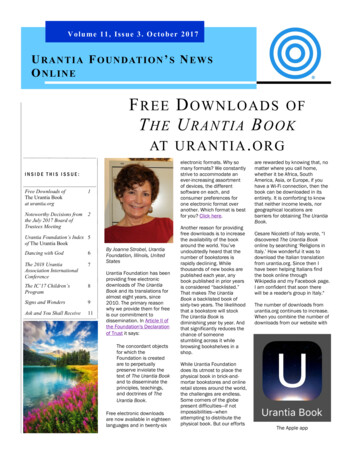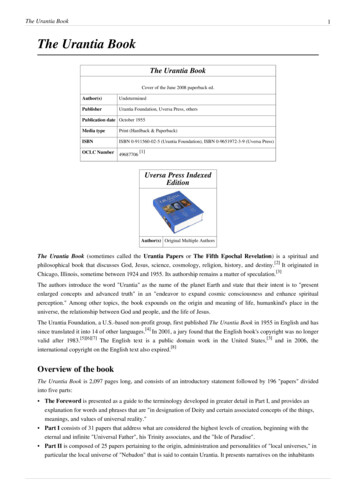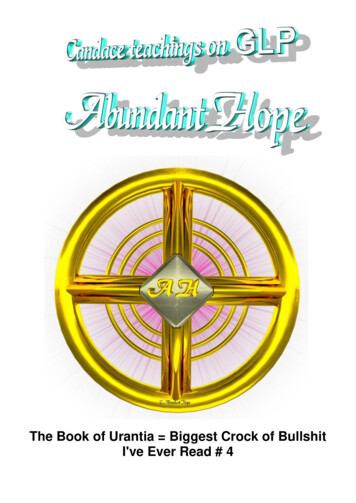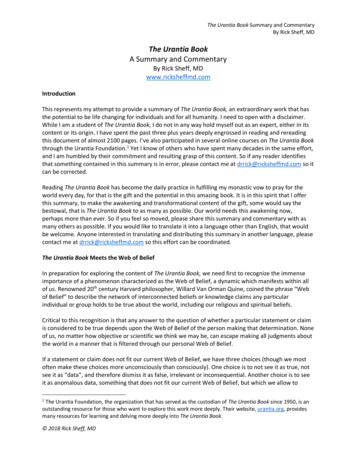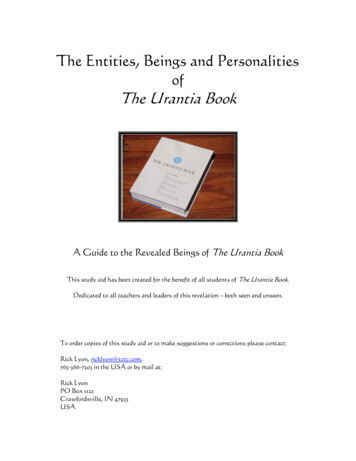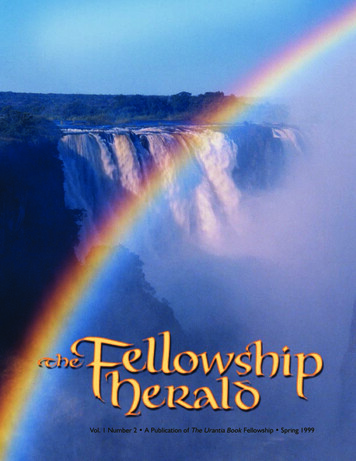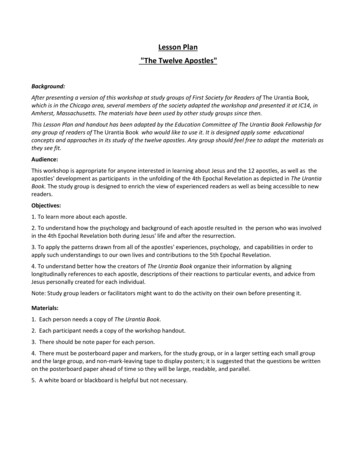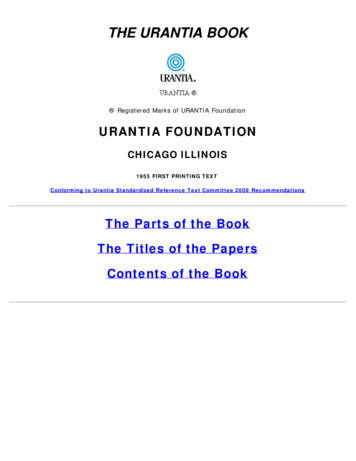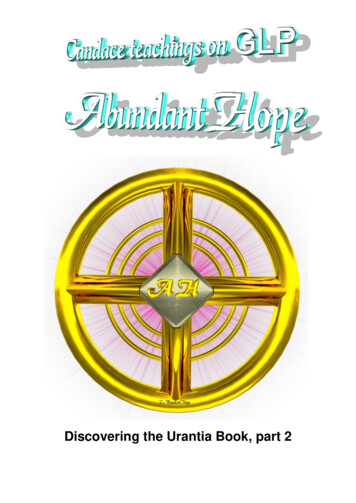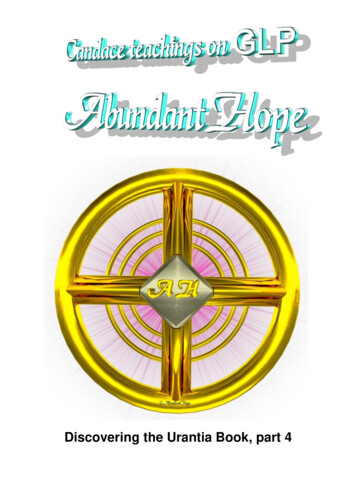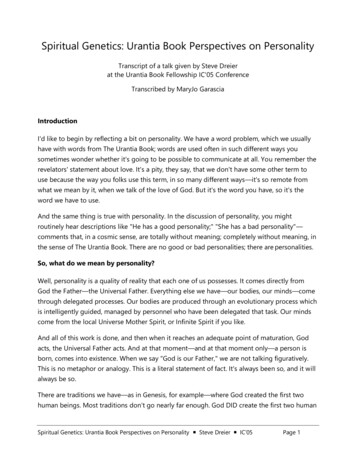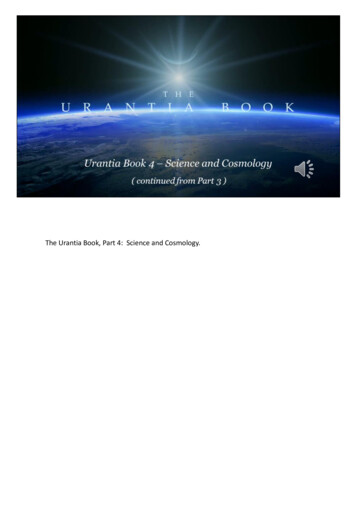
Transcription
The Urantia Book, Part 4: Science and Cosmology.
“The world is an amazing place.”And the more we learn about the world, the more amazing it becomes.Whether it’s sorting out how DNA really works, how mind relates to brain, or whatmass and matter really are, our prize winning theories, our best philosophies, fallshort and fail to explain what’s really going on.Even today, Shakespeare's famous words still hit the spot: there are “more things in heaven and on earth”than we can imagine.2
Or as scientists like to say,“The universe is not only stranger than we imagine,it’s stranger than we can imagine.“So how do we go about discovering – and then exploring – things we can’t evenimagine?3
Well, we can go a long, long way with Reason. Think of all the once unimaginablethings – about the subatomic world, about the mechanisms of material life – that ourscientific method has revealed.But what about things we can’t measure, those things which reason can’t grasp, like“meaning”, and “value”?4
This is where Philosophy steps in, and takes us all the way to the “full philosophiclimit”. And this was Shakespeare’s point: that our science and philosophy define theframe within which our reason and wisdom can act.So here we are, stuck within our frame, tickled by numinous intuitions, that take ourbreath away.5
In paper 115, the Urantia Book puts it like this:“Man must think in a mortal universe frame, but that does not mean that he cannotenvision other and higher frames within which thought can take place.”(1260.3, 115:1.2) “Conceptual frames”6
In part 1 (of this series) we looked at this idea, of “a frame in which to think”;how our frames expanded and evolved,and how a scientific materialism has driven us to where we are today.
So, are we there yet?Does this extraordinary map, of energy evolving in space, forced on by some “arrowof time”, capture the highlights of universe history?Or in a few short years, will our children’s children look back, and wonder,“How could they have missed so much?”8
In parts 2 and 3 of this series we looked at the questions of what and why we are.But I promised I’d get back to this question of where.9
So in this final part, we turn to more “cosmological” questions.10
Previously, I said:“the Urantia Book describes our place in a finite manifold, in a more than finitespace.”To a physicist, this involves a few extra dimensions of space,and the “sequestering” of particles and forces.11
and spacetime becomes a finite slice, upon which creation can evolve.12
Since about 1995, such ideas have become almost mainstream. For example, in her2005 Paper [*] “Relaxing to Three Dimensions”, physicist Lisa Randall sketched outhow such a scheme might work:Given some unqualified 10-dimensional potential, nature favours the eventuation of7 and 3 dimensional sub-manifolds.To put this in “Urantia Book” terms: from the potentials of an Unqualified Absolute, within an “absolutely ultimate” bestowal, “membranes of creation” can evolve.But such things are hard enough to imagine, let alone to measure. So let’s stepback [*] Lisa Randall, “Relaxing to Three Dimensions”, http://arxiv.org/abs/hep-th/050605313
to where science currently is and ask the question: “Does the Urantia Book offeranything, anything at all, that might help to explain, or even to extend, thesestandard models – of particle physics, and of cosmology – that native science hasevolved?”Maybe.First thing to note we have two “standard models”, not one. Scientists mappinggalaxies built one model, to match what telescopes reveal. Other scientists,exploring the weird behaviour of particles in the lab, were forced to invent a secondmodel, a “mechanics of quantum fields”.As we know, these two models are famously incompatible with each other.So what’s the problem?14
The problem is that for standard Big-Bang cosmology to work, space needs to bemostly empty average energy density about 10 to the power -9 (Joules per cubic meter)15
But for quantum field theories to work, space needs to be very, very full – implyingsome outrageous energy density pervading the vacuum of space.It’s things like this that make the mechanics of Quantum Fields incompatible withthe mechanics of General Relativity.But the Urantia Book describes something new. In the Urantia Book scheme,something called segregata (or “pure energy”) is segregated into dense halos. It’swithin these energy-rich halos that a dark form of mass, and then galaxies, can form.16
Here’s another look: from some (passive and potential) force-charge of space, a poolof (activated and primordial) “pure energy” is swirled into a vast cyclone of space.This activation and segregation provides the energy density needed for quantumfields. But notice, what we have here is angular momentum in a super-fluid, which(as everybody knows) leads to interesting physics. And sure enough, within thisenergy rich halo, angular momentum is quantized, a dark form of mass appears, andparticle genesis begins.Also worth noting – in this scheme, it’s this dark, ultimatonic mass that drives thegalactic dynamics we observe. The stars themselves are like fluff, floating and framedragged in a vast dark pool.Of course, such a scheme implies new foundations for physics, and some fresh ideasabout space and time.As we’ll see, this Urantia Book appears to provide both.17
Here’s the plan: we’ll begin with a quick review of the Urantia Book’s uniquefoundations for physics. Then we’ll look at what these foundations mean for massand matter.With this background in place, we’ll take a fresh look at what happens when masscollapses not to black holes, but to “dark islands”, that can explode.Finally, I’ll mention some surprising implications for our ancient “Milky Way”.As we work through all this, keep in mind those “limitations of revelation” discussedin paper 101 section 4. As the revelators explain, they were constrained by what wemight call a “prime directive” : things which we can discover for ourselves, we mustdiscover for ourselves.But what about things that human science can never prove, like Planck-scaleinteractions, or the global shape of space? If something is not discoverable, do thoselimitations apply?Let’s begin with those foundations.18
A good way to get a feel for Urantia Book physics is with a standard spiral galaxy.For example, here’s the famous “Silver Dollar”, a galaxy of 100 billion stars, 10 millionlight years away.When we look at such a thing – with electromagnetic telescopes – we see somethinglike [this] : a flat disk of stars, here seen almost edge on.19
This visible galaxy, this tiny spiral of electromagnetically bright stuff, is what theUrantia Book calls gravita, standard model stuff like atoms and photons.But the Urantia Book adds a few things to this picture { gravita, ultimata, segregata, absoluta } and introduces “force organizers” who spin up vast cyclones of segregata,condensed from absoluta.As the story goes, it’s within these isolated islands of segregata 20
that so-called “associate force organizers” evolve halos of ultimata,from which “power directors” arrange gravita, the standard-model stuff from whichstars and galaxies are made.Here we see how these Urantia Book terms fit in: gravita is built from ultimatons, ultimata evolves in segregata, and segregata is condensed from absoluta.A couple of things to note:[First], segregata is described as a “primordial force-charge”, condensed from aglobal potential.In modern terms, we’d call this a “Higgs-type” field (or condensate of charge).21
And [second], in the Urantia Book scheme, ultimata is the foundation for mass.All mass, both the so-called absolute and interactive kinds.So a halo of ultimata must be massive.But ultimata is also pre-electronic, so this halo of mass has no electric charge.But no electric charge means no photons no electromagnetic radiationSo this halo of mass is dark.22
What we have here is a tiny spiral of fluffy stars, embedded in a vast halo of darkmass, exactly what our standard models of cosmology need (and now assume) butcan’t explain.So in this simple picture we find the foundations of standard model physics: ultimata serving as the dark mass required by cosmology, and segregata, serving as that condensate of charge (or Higgs-type field) that allowsparticle physics work.[note: label “ultimata” floats down towards center during animation]23
So, while [this] is what astronomers currently observe, something more like [this] iswhat a Solitary Messenger might see, “as they pass by.”And one more thing. In papers 41 and 42, [they write] that particles of light movethrough open space as fusillades, or little bullets.But when ploughing through these cyclones of segregata (or primordial charge) theirpath through space starts to wiggle.As we’ll see, in the Urantia Book story, segregata serves as a medium in whichparticles of light appear to wave. a medium in which particles of light appear to wave.At this point I won’t mention red-shift, but thereby hangs a tale.24
Ok, so that’s a quick look at the unique foundations on which the Urantia Book’sscientific story sits.Let’s see what this means for mass and matter.25
Urantia Book calls gravita, standard model stuff like atoms and photons. ut the Urantia ook adds a few things to this picture { gravita, ultimata, segregata, absoluta} and introduces “force organizers” who spin up vast cyclones of segregata, condensed from absoluta. As the story
